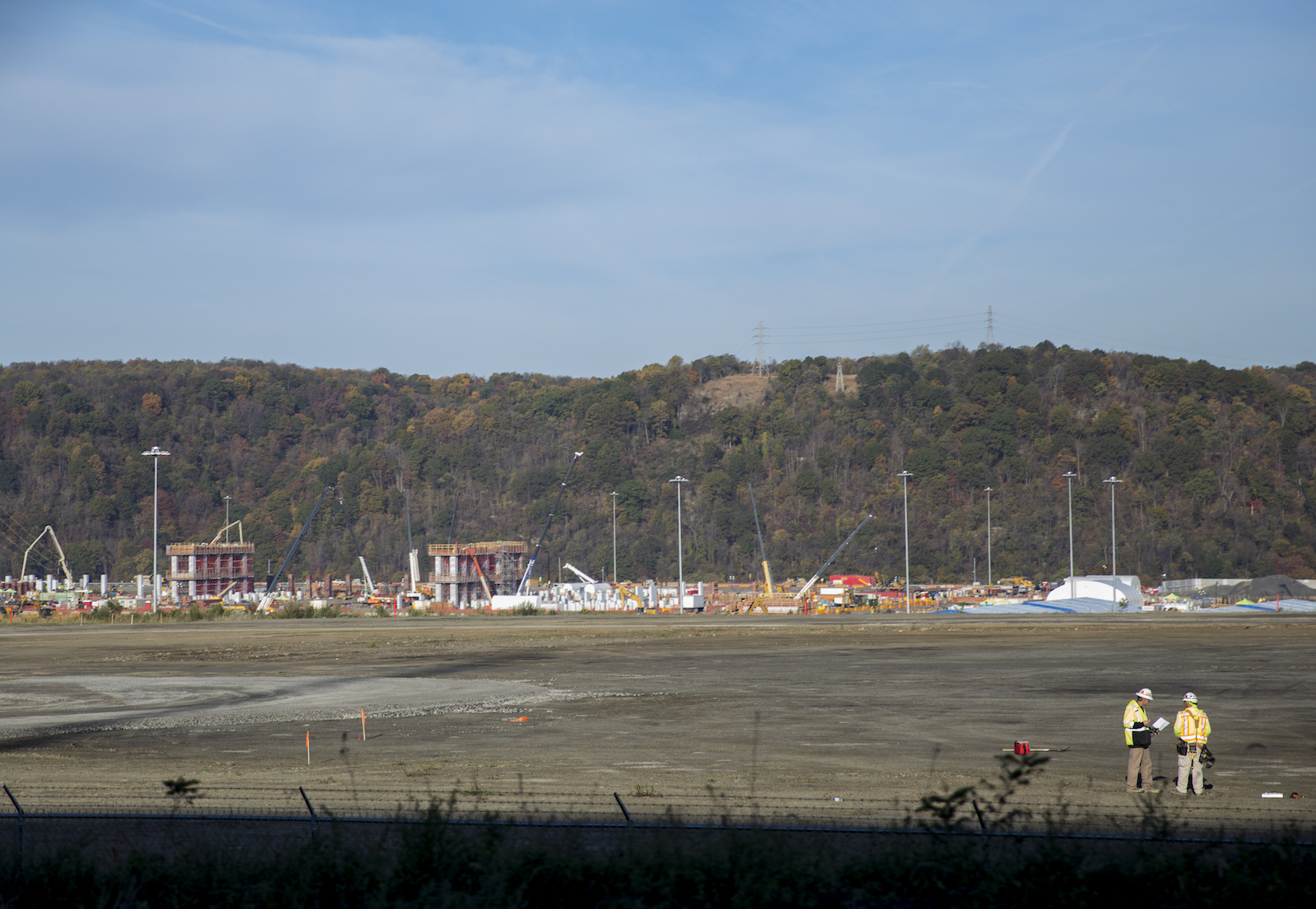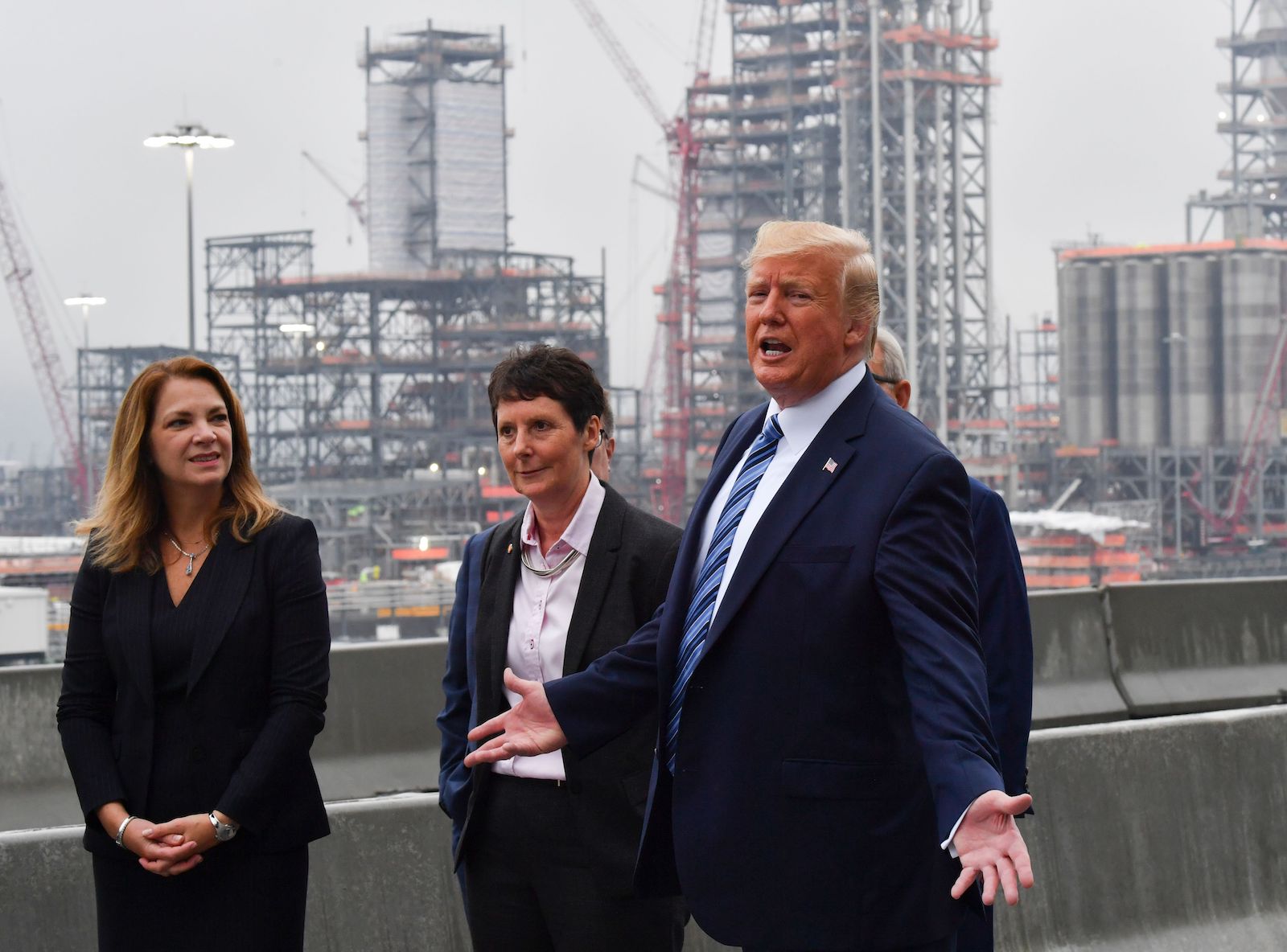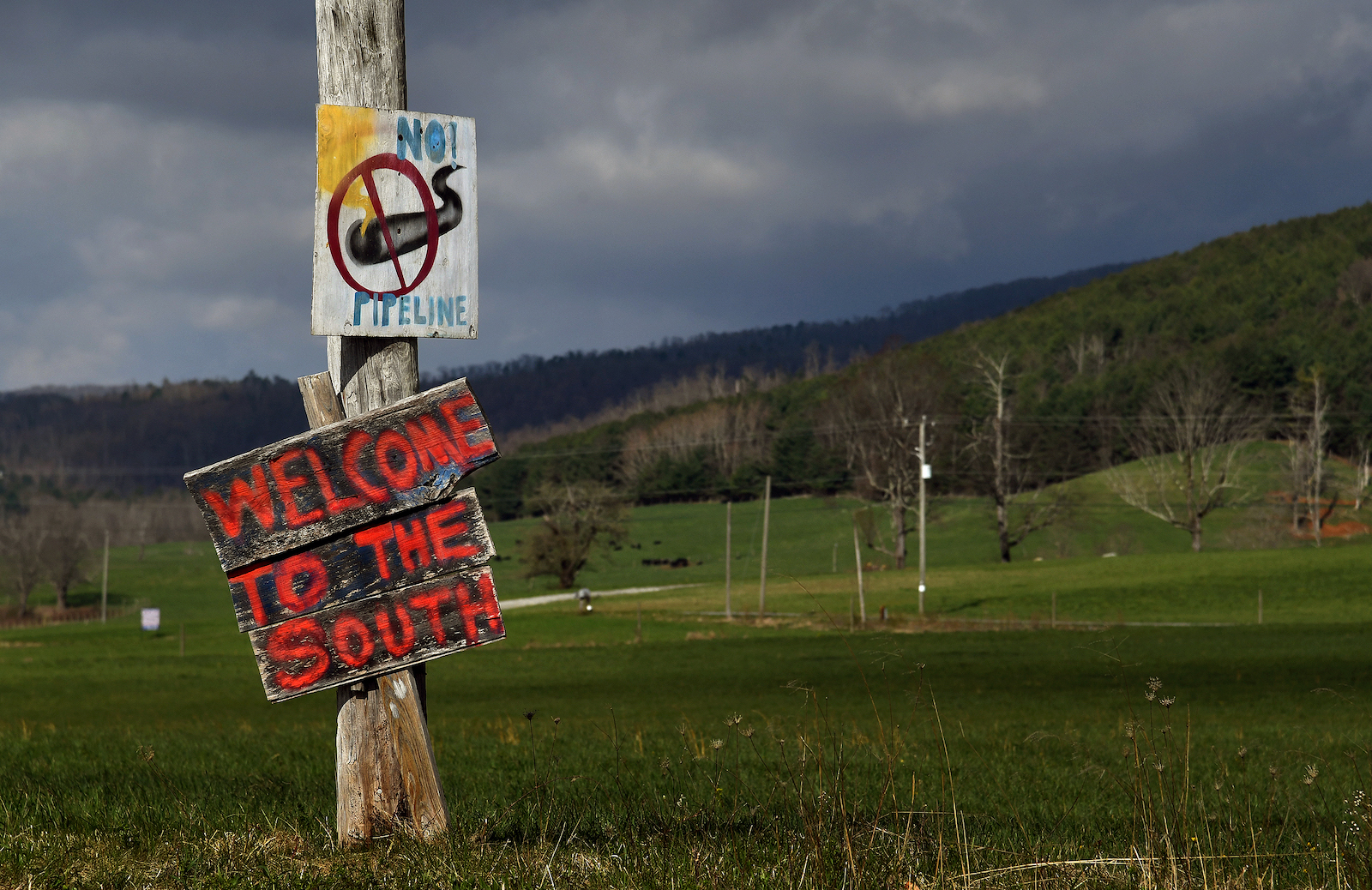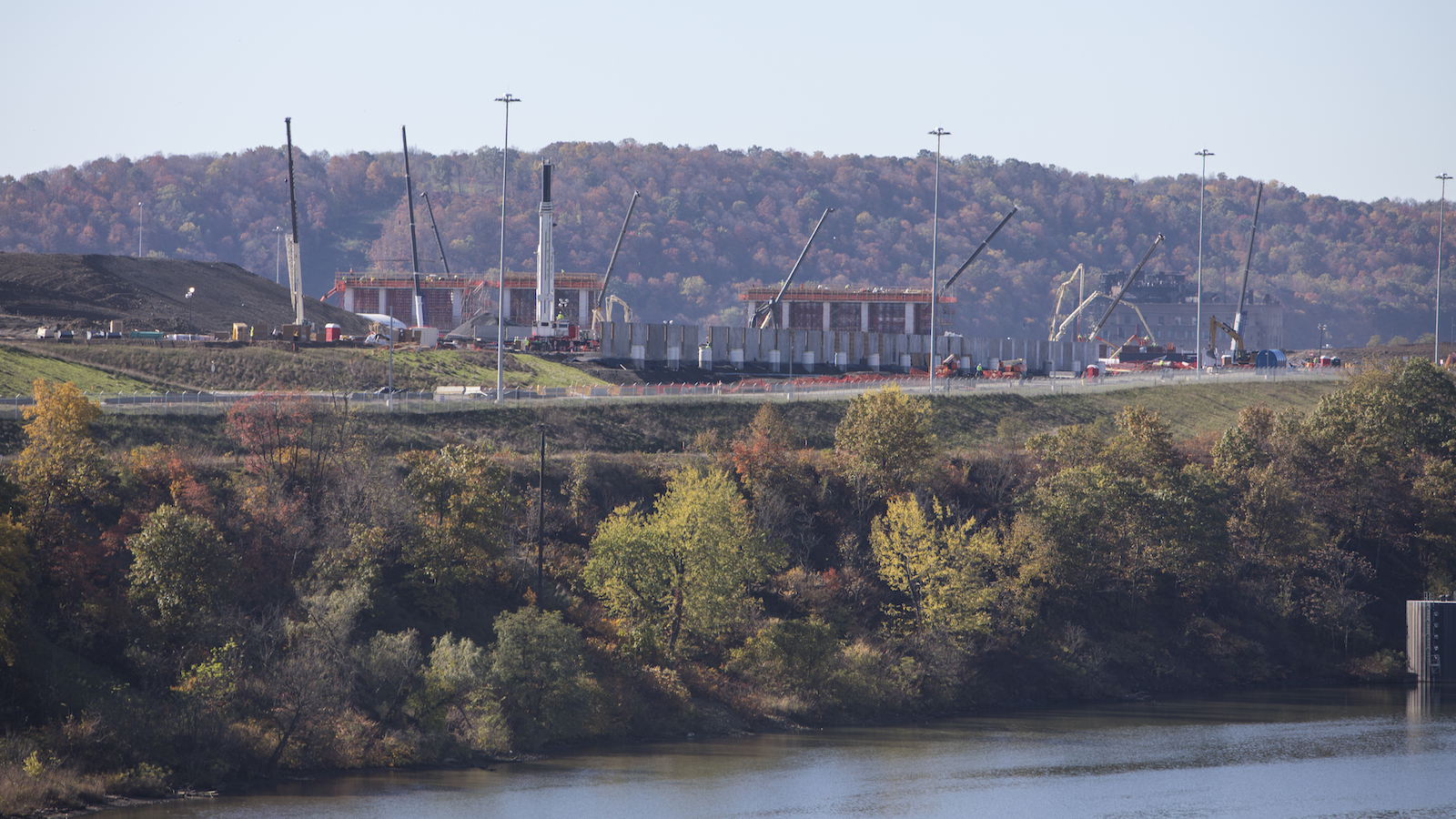This story was originally published by Yale Environment 360 and is reproduced here as part of the Climate Desk collaboration.
Karen Gdula lives in the house she grew up in, a modest home on a pretty street in rural western Pennsylvania. Ivy Lane, in her view, is someplace special. “There’s a warmth and a caring,” she said. “We look out for each other.” The street never needed those bonds more than on September 10, 2018.
Retired and newly married, Gdula was asleep when, just before 5 a.m., an explosion shook her home. The roar was so loud that some of her neighbors thought it was a plane crash. But when she and her husband saw a fireball stretching above the tops of the towering pine trees across the street, they knew exactly what had happened.
The Revolution Pipeline, running right behind Ivy Lane in Center Township, about 25 miles northwest of Pittsburgh, had come into service only days before, carrying gas from the fracking wells that are everywhere in the region. No one was hurt, but the explosion flattened a home three doors down from Gdula’s and toppled six giant electrical transmission towers.
Now, Revolution is back in service, and another pipeline has come to Ivy Lane, too. It’s called Line N, and it feeds gas to the vast, $6 billion petrochemical plant Shell is building five miles away in Monaca, right on the Ohio River. That plant, called an “ethane cracker,” will soon turn ethane — a byproduct of fracking — into 1.6 million tons of raw plastic a year.
Five years ago, the flood of ethane coming from the Ohio River Valley’s fracking wells got the plastic industry — petrochemical firms that are often subsidiaries of big fossil fuel producers — dreaming about a new generation of massive plants in the region. Companies envisioned building as many as four more ethane crackers like Shell’s in Appalachia, and state and local officials from both parties embraced the idea.
That vision is now foundering. Obstacles including global overproduction of plastic, local opposition to pipelines that feed such facilities, and public concern about the tidal wave of waste choking oceans and landscapes mean that even the region’s second proposed ethane cracker may never materialize. Additional plants look even less likely. The question mark over the industry’s once-grand hopes for Appalachia reflects larger doubts about its plans for dramatically increasing worldwide plastic production.
Driving oil and gas companies’ plastic production ambitions is the understanding that action on climate change may soon reduce demand for their fuels. Plastic is central to their hopes of keeping profits flowing, so they’ve been pouring money into building new plants and expanding old ones, on track to double 2016 global plastic production levels by 2036. Fracking has made the United States a major player in this international buildout. The American Chemistry Council, an industry association, says companies are investing more than $200 billion in U.S. chemical projects using fracked ingredients. Most of that growth has happened on the Gulf Coast, the country’s long-standing petrochemical hub.
The Ohio River Valley — desperate for economic revival after the steep decline of its coal and steel industries — was supposed to be the site of the next big push. Like many in the region, Gdula has complicated feelings about petrochemicals. She spent much of her career at a company that designed equipment for oil and gas workers, so she was not someone predisposed to distrust the industry. But after the explosion, she was dismayed to realize that much of its infrastructure was feeding plastic plants. And not just locally: Pennsylvanian ethane flows by pipeline to the Gulf Coast and Canada, and to a port near Philadelphia where it is shipped to European plastic producers.

Gdula is resigned to living with the industry, but she wants politicians and regulators to better safeguard residents’ well-being. In the wake of the explosion, she’s concluded that when Pennsylvania makes decisions about new projects, “jobs will aways trump everything. I hope safety is a close second.”
Her outlook reflects the push and pull of big promises and nagging fears as a region that was once one of America’s great industrial corridors wrestles with whether to tie its fortunes to another toxic, boom-and-bust industry like coal or fracking. And because plastic production has a hefty climate footprint — along with its more visible impact on waste — the consequences of what happens in Appalachia will stretch far beyond the region’s depressed downtowns, winding creeks, and peaceful hollows.
The Ivy Lane blast highlighted the safety concerns around Pennsylvania’s thousands of miles of pipelines. Revolution’s owner was charged with nine counts of environmental crimes and agreed to $2 million in fines and upgrade costs. Separately, the U.S. pipeline safety agency issued a warning to Shell over missing padding — a safety concern — on part of the Falcon pipeline, which will carry ethane to its plant. The company says the line is safe and the issue was isolated. Opponents believe it highlights a much wider problem — regulators’ coziness with oil and gas interests, whose projects they approve too readily and fail to adequately police.
The explosion also offered a glimpse of the many tentacles of plastic production’s health and environmental effects, which extend far beyond the plants’ direct impacts. “It’s the whole network, the whole big spider web of this chemical plant being built around us,” said Terrie Baumgardner, of the Pennsylvania Clean Air Council.
By creating a market for ethane, plastic production drives more fracking, with the well-documented health and climate dangers it poses. One study found that the $23 billion toll of air pollution from fracking in the region — including between 1,200 and 4,600 premature deaths over 12 years — outweighed the economic gains, which researchers put at $21 billion. A plant the size of Shell’s needs more than 1,000 fracking wells to supply it with ethane, Duquesne University’s Center for Environmental Research estimates.
And the plants pose their own dangers. “Cracking” ethane’s molecules to turn it into ethylene — which is then processed into polyethylene, the world’s most widely used plastic — can emit benzene, toluene, and formaldehyde, which are linked to leukemia, nervous system damage, and respiratory problems, respectively. Shell’s facility will also create pollutants including sulfur dioxide and particulate matter, which increase risks of cancer, heart problems, and other ailments. The company declined an interview request, but has said the plant complies with all regulations.
Plastic production’s climate impact is sizable, too. With its energy-hungry cracking plants — Shell’s Monaca facility is allowed to emit as much carbon dioxide annually as about 430,000 cars — and the methane-leaking pipelines that feed them, the U.S. plastic industry’s greenhouse gas emissions equal those from 116 coal-fired power plants, estimates Beyond Plastic, an advocacy group. Domestically, that footprint is expected to exceed coal’s by 2030, the group predicts. Globally, plastic would be the world’s fifth-largest greenhouse gas emitter if it were a country, Beyond Plastic says. If output grows as planned, plastic would use more than 10 percent of the emissions allowable if warming is to stay below 1.5 degrees Celsius, says the Center for International Environmental Law.
In the river towns of western Pennsylvania, southeastern Ohio, and West Virginia, many see petrochemicals as a lifeline that will not only provide good jobs and tax revenue, but help spark broader growth. Especially after the pandemic exposed the vulnerability of global supply chains, supporters say the plastic produced by Shell — and perhaps eventually other producers — will attract manufacturers to turn it into goods and packaging.
Embracing such hopes, Pennsylvania gave Shell a tax break valued at $1.6 billion, one of the largest in state history. The company’s decision to build “put Beaver County back on the map,” said Jack Manning, a county commissioner. “That plant gave more people hope than any other single thing” in decades. Early in the pandemic, plant construction workers’ spending at local shops and restaurants “really helped us survive,” and he predicted such indirect economic benefits would continue.
Others have doubts. The Ohio River Valley Institute, a liberal research group, says Beaver County’s growth lags the rest of the state despite the huge construction project.
Six miles from Shell’s site, Mayor Dwan Walker runs Aliquippa, once a storied steel-making town, from a bare-bones City Hall on a street lined with empty storefronts. With tattooed arms and a red Aliquippa polo shirt, he’s ready to welcome just about anything that will bring back jobs and revenue. But he sees Shell’s plant as a mixed blessing. “The good news is the cracker plant’s coming. Guess what the bad news is — the cracker plant’s coming,” he says. “There’s a lot of questions I have.”
While 8,000 workers are building the plant, there will only be 600 permanent jobs once it opens. So far, many workers are from out of state. Walker sees license plates from all over the country, just as he did during fracking’s boom years, when oil and gas workers came from as far as Texas and Oklahoma to take good-paying jobs.
Aliquippa is one of the few racially diverse towns in a largely white area, and a lot of obstacles stand between its residents, many of them Black, and permanent jobs with Shell, Walker said. Many don’t own cars, and few have the training to work in an ethane cracker. At the company’s community meetings, “they kept talking about diversity,” the mayor recalled. “Explain to me what that looks like.” One thing he wants to know: “Do I see people saying, ‘Here’s a voucher for a taxi or an Uber’” to get residents without cars to community colleges or other training sites?

Walker understands the risks of petrochemicals — the Gulf Coast plastic-making corridor is nicknamed “Cancer Alley” because of the industry’s toxic footprint. On the other hand, when Shell set up a construction staging area in Aliquippa, the town got an influx of tax income. And while there may not be many residents employed in the plant, Walker is among those who believes it will attract other companies. His town has docks on the Ohio River and plenty of industrial land waiting for the right manufacturer. “This is a city that’s been on its knees. It’s been crawling for a while, and now we’re starting to walk,” he said. “And pretty soon, we’re gonna run.”
Like Gdula, Walker is ambivalent about the industry. Would he prefer to have seen different opportunities for his constituents? “Yes and no,” he says. It wasn’t up to him, but now his job is to make sure those in charge don’t forget Aliquippa.
Belmont County, Ohio has similar hopes. It’s a little over an hour’s drive downriver from Shell’s site, along a stretch of the Ohio lined with the rusting skeletons of abandoned factories. There’s gentle beauty too, in the rolling green hills thick with springtime blossom and birdsong. Tucked inside the elbow of one of the river’s sharpest bends, a grassy field where a towering coal-fired power station once stood is empty now, its fate unclear since the Thai petrochemical conglomerate PTT Global Chemical (PTTGC) lost its investment partner for the $10 billion ethane cracker it hopes to build there.
Dan Williamson, a PTTGC spokesman, said such projects often have long gestation times, and that the pandemic’s disruptions had created additional delays. The company is looking for a new partner and remains optimistic it will eventually build. The plant would employ about 500 people, he said, and require thousands of construction workers to erect.
For now, Belmont County is in limbo. The petrochemical industry’s global building spree — including a wave of new plants in China — appears to have gone too far, at least for now. “We’re entering into a period of overcapacity,” said Nathan Schaffer, vice president for petrochemicals at the consulting group Wood Mackenzie. “Supply has outpaced demand” and will take a few years to catch up, he said.
Measures to reduce plastic waste may complicate that equation. The European Union, Canada, and more than 30 African nations are among locales banning some single-use items. There’s a push to use more recycled material and plans for a global plastic pollution treaty. So the plastic industry’s long-standing assumption that demand tracks economic growth may no longer hold, said Anne Keller, an expert in natural gas liquid and petrochemical feedstocks at Midstream Energy Group, a Texas-based consultancy.
Because of the mix of ingredients available in Appalachia, much of the region’s plastic output would likely go to single-use items such as bags and packaging, making producers particularly vulnerable to pollution concerns, Keller said. The Australian Minderoo Foundation ranked PTTGC as the world’s 19th largest producer of plastic for throwaway items, finding it made the material for 1.5 percent of all single-use plastics globally. Williamson, the company spokesman, said it takes environmental concerns seriously, and sees ocean plastic pollution as a crisis.
Opposition to new pipelines is another obstacle, Keller said. Just a few years ago, fracking companies saw the proposed new crackers as an enticing way to monetize ethane they needed to get rid of. “That’s changed,” she said. Now pushback against new pipelines — Mountain Valley, in West Virginia and Virginia, is the latest to run into trouble — threatens to limit the flow of methane leaving the region to be sold for heating and power. If it does, the difficulty of reaching markets will constrain new drilling, tightening the supply of ethane on which the plastic dreams were built. Five years ago, few “would have ever thought that it would literally have become impossible to build a pipeline out of this region,” Keller said. But there’s been so much opposition “that that’s really become a question mark.”

It’s too soon to know whether the Ukraine war, and Europe’s scramble to replace Russian gas, might upend that political dynamic, providing justification for new pipelines to carry fuel for liquefaction and export. Barring that, for PTTGC “it’s simple economics,” Keller said. Uncertainty around ethane supplies means building “looks a lot riskier than it did a few years ago.” Meanwhile, inflation is driving up construction costs, Schaffer said. All told, it means new Appalachian plants, in his view, are “probably off the table for now.”
Greg Kozera, a spokesman for Shale Crescent USA, which advocates for petrochemical development in the region, disagrees. The disruptions of the pandemic and war make the case for Appalachian plastic production stronger than ever, he argues. “We can’t depend on a global supply chain,” he said. “Companies are looking for regional suppliers.”
He added that eliminating international shipping costs means U.S. manufacturers using Appalachian plastic can compete with Asia on price, even if U.S. labor costs are higher. “We’re going to see the crackers, I’m convinced of that,” Kozera said.
Ed Good hopes he’s right. A trustee of Mead Township, which includes Dilles Bottom, home to PTTGC’s site, he worked 35 years at the R.E. Burger coal power plant, which closed in 2011; PTTGC knocked it down after acquiring the land. When the plant laid off staff in the 1990s, a federal program helped workers retrain, or go back to school, recalled Good, a longtime union official. There’s little such help available now, and with state cuts to local government support, towns are on their own too. “When Burger shut down I lost half my budget,” he said. “We don’t pave as many roads as we used to.”
When PTTGC expressed interest, “we saw the potential and what it meant for the township, what it meant for the community, schools.” Eventually, the company agreed it would pay the township $2 million upon a decision to build, and $500,000 annually afterwards. Nearby Shadyside secured a pledge of $38 million for a new school complex if the plant goes ahead.
Just across the Ohio, in Moundsville, West Virginia, Amanda and Eric Petrucci are waiting anxiously for word on the project too. The home where they’re raising their four children sits on a woodsy hilltop with a view that takes in the river and the low green mountains that run beside it. But they can also see flames licking up from a gas processing plant, and a nearby meadow is a Superfund site, contaminated by decades of chemical production.
Whenever there’s been activity there — cleanup work or soil removal — “it always leads to somebody being sick” in the family, Eric Petrucci said. As a toddler, their now-teenage son developed a rare, but temporary, blood disorder. Two neighbors got brain tumors, and another suffered kidney failure. “Every house has had somebody die of cancer,” Amanda Petrucci said. Eric Petrucci developed severe lung problems that took years to clear.
When the gas plant opened, their home’s water turned black, and Amanda Petrucci started getting tics and migraines. She has wanted to move away for years, but her husband, whose parents built their home, feels deeply rooted in the area. An ethane cracker about two miles away would end that debate, forcing them to leave, they say. And if PTTGC builds, an associated project — underground caverns to store ethane next to the river — will likely proceed too. “I’m constantly worried about it,” Amanda Petrucci said.
State representative Sara Innamorato, a Pittsburgh Democrat who is among a small minority of Pennsylvania lawmakers opposing petrochemical expansion, thinks Appalachia can do better than to entangle itself further with fossil fuels and their byproducts. Shell’s tax break could have financed more sustainable development, she said: “That’s $1.6 billion less we have to put into Main Street businesses, or technical and career colleges, or to allow for a small business that’s operating here to expand,” or help factories upgrade to reduce emissions.
Oil and gas companies’ political donations have stymied development of any alternative plan, she believes. There’s plenty of room “to think creatively about the future of energy, the future of jobs, and the future of other industries.” The challenge, Innamorato said, “is just getting people to see it doesn’t need to be this way. There can be another vision.”



